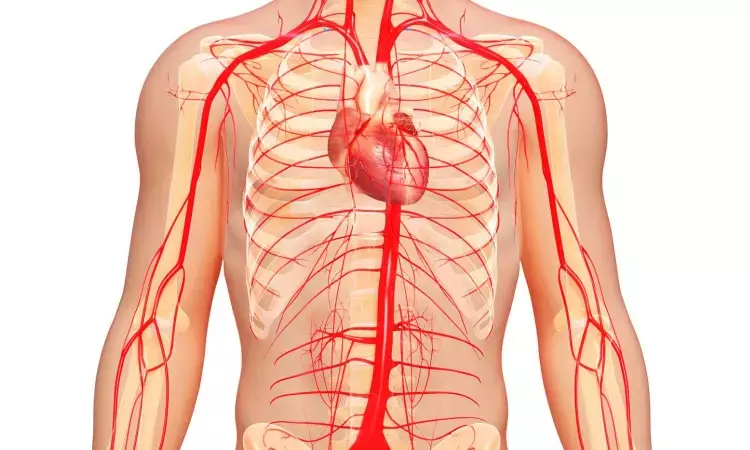- Home
- Medical news & Guidelines
- Anesthesiology
- Cardiology and CTVS
- Critical Care
- Dentistry
- Dermatology
- Diabetes and Endocrinology
- ENT
- Gastroenterology
- Medicine
- Nephrology
- Neurology
- Obstretics-Gynaecology
- Oncology
- Ophthalmology
- Orthopaedics
- Pediatrics-Neonatology
- Psychiatry
- Pulmonology
- Radiology
- Surgery
- Urology
- Laboratory Medicine
- Diet
- Nursing
- Paramedical
- Physiotherapy
- Health news
- Fact Check
- Bone Health Fact Check
- Brain Health Fact Check
- Cancer Related Fact Check
- Child Care Fact Check
- Dental and oral health fact check
- Diabetes and metabolic health fact check
- Diet and Nutrition Fact Check
- Eye and ENT Care Fact Check
- Fitness fact check
- Gut health fact check
- Heart health fact check
- Kidney health fact check
- Medical education fact check
- Men's health fact check
- Respiratory fact check
- Skin and hair care fact check
- Vaccine and Immunization fact check
- Women's health fact check
- AYUSH
- State News
- Andaman and Nicobar Islands
- Andhra Pradesh
- Arunachal Pradesh
- Assam
- Bihar
- Chandigarh
- Chattisgarh
- Dadra and Nagar Haveli
- Daman and Diu
- Delhi
- Goa
- Gujarat
- Haryana
- Himachal Pradesh
- Jammu & Kashmir
- Jharkhand
- Karnataka
- Kerala
- Ladakh
- Lakshadweep
- Madhya Pradesh
- Maharashtra
- Manipur
- Meghalaya
- Mizoram
- Nagaland
- Odisha
- Puducherry
- Punjab
- Rajasthan
- Sikkim
- Tamil Nadu
- Telangana
- Tripura
- Uttar Pradesh
- Uttrakhand
- West Bengal
- Medical Education
- Industry
Study Links TG/HDL Ratio, Not TyG Index, to Arterial Stiffness in Prediabetes

Italy: A recent study published in Diabetes Research and Clinical Practice has highlighted the potential of the triglycerides-to-high-density lipoprotein cholesterol ratio as a valuable marker for assessing cardiovascular (CV) risk in individuals with prediabetes. The research found that TG/HDL, rather than the triglyceride-glucose (TyG) index, was significantly associated with arterial stiffness, a key indicator of early vascular damage.
Prediabetes (preD) is known to increase the risk of cardiovascular events compared to individuals with normal glucose tolerance (NGT). This heightened risk is largely due to insulin resistance, a key feature of prediabetes, which plays a major role in cardiovascular complications. To assess this risk early, researchers have increasingly turned to surrogate markers of insulin resistance, such as the triglycerides-to-HDL cholesterol ratio (TG/HDL) and the triglyceride-glucose index.
In this context, Maurizio Di Marco, Department of Clinical and Experimental Medicine, University of Catania, Catania, Italy, and colleagues explored how these markers relate to cardiovascular risk in prediabetic individuals, particularly through their association with arterial stiffness—an early indicator of vascular damage.
For this purpose, the researchers enrolled 377 individuals without a prior diagnosis of diabetes. All participants underwent comprehensive biochemical testing and an oral glucose tolerance test. To assess cardiovascular risk, measurements of arterial stiffness were taken, including pulse wave velocity (PWV), augmentation index (AugI), and intima-media thickness (IMT). Based on current clinical guidelines, the participants were categorized into three groups: those with normal glucose tolerance (NGT, n = 100), individuals with prediabetes (preD, n = 216), and those newly diagnosed with type 2 diabetes (ND-T2D, n = 61).
The study revealed the following findings:
- People with prediabetes had higher TG/HDL and TyG levels compared to those with normal glucose tolerance.
- TG/HDL levels in prediabetes were similar to those in newly diagnosed type 2 diabetes.
- Individuals with prediabetes showed greater arterial stiffness and vessel thickness, reflected by higher PWV, AugI, and IMT readings.
- In the prediabetes group, PWV showed a significant link with TG/HDL, even after accounting for major influencing factors.
- There was no clear association between PWV and TyG.
- There was a weak trend linking PWV to HOMA-IR, but it was not statistically significant.
- Those in the highest TG/HDL group were more than twice as likely to have increased PWV, suggesting a higher cardiovascular risk.
"The study highlights the potential of the triglycerides-to-HDL cholesterol ratio (TG/HDL) as a simple, non-invasive, and cost-effective marker for assessing cardiovascular risk in individuals with prediabetes," the authors wrote. They added, "The independent association between TG/HDL and arterial stiffness, measured by pulse wave velocity, suggests its usefulness in evaluating early vascular changes linked to insulin resistance."
"However, further longitudinal studies are needed to confirm these findings and support its application in routine clinical practice," they concluded.
Reference:
Marco, M. D., Scilletta, S., Miano, N., Capuccio, S., Musmeci, M., Mauro, S. D., Filippello, A., Scamporrino, A., Bosco, G., Giacomo Barbagallo, F. D., Scicali, R., Piro, S., Purrello, F., Wagner, R., & Pino, A. D. (2025). Triglycerides to high density lipoprotein cholesterol ratio (TG/HDL), but not triglycerides and glucose product (TyG) index, is associated with arterial stiffness in prediabetes. Diabetes Research and Clinical Practice, 112189. https://doi.org/10.1016/j.diabres.2025.112189
Dr Kamal Kant Kohli-MBBS, DTCD- a chest specialist with more than 30 years of practice and a flair for writing clinical articles, Dr Kamal Kant Kohli joined Medical Dialogues as a Chief Editor of Medical News. Besides writing articles, as an editor, he proofreads and verifies all the medical content published on Medical Dialogues including those coming from journals, studies,medical conferences,guidelines etc. Email: drkohli@medicaldialogues.in. Contact no. 011-43720751


